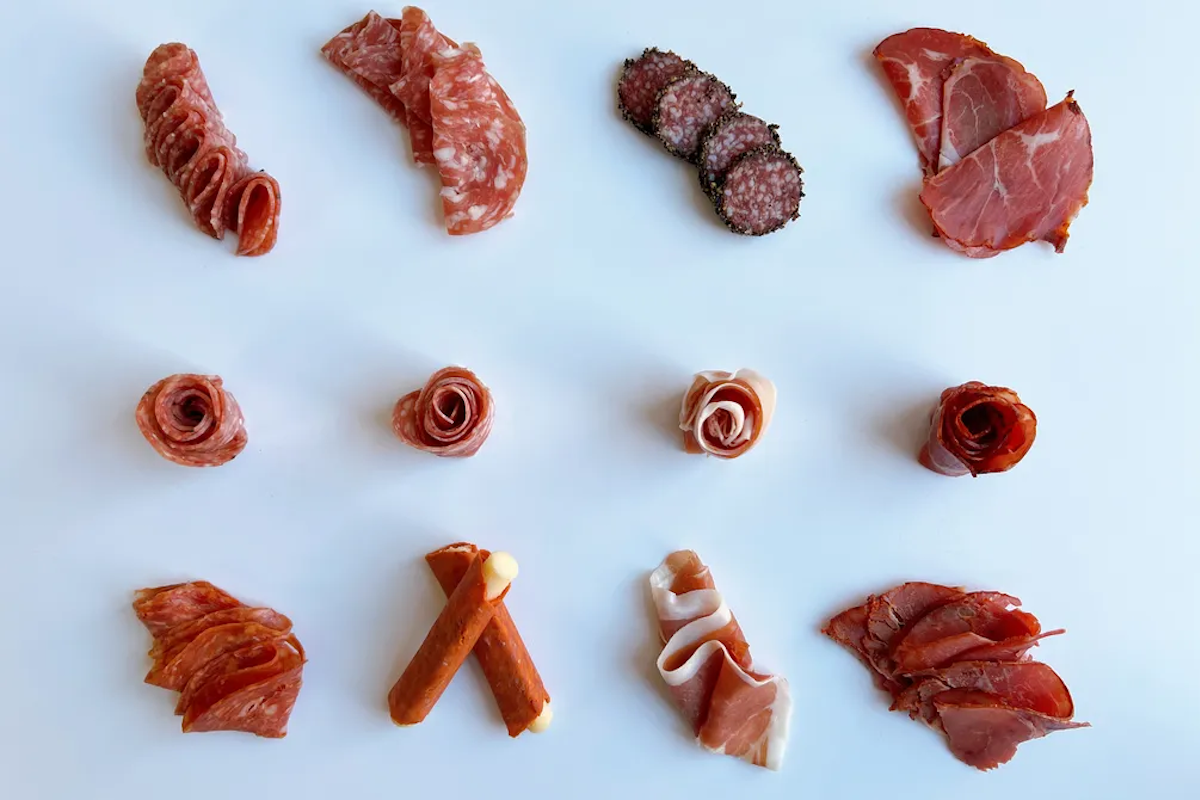That Cheese Plate is a column by Marissa Mullen — cookbook author, photographer, and Food52's Resident Cheese Plater. With Marissa's expertise in all things cheddar, Comté, and crudité — plus tips for how to make it all look extra special, using stuff you probably have on hand — we'll be crafting our own cheesy masterpieces without a hitch. This month, Marissa is letting us in on some tricks of the trade when it comes to styling charcuterie.
Charcuterie is an essential element of any cheese board, adding robust flavors ranging from cured salt and red wine to fennel and cracked black pepper. The word "charcuterie" is derived from the French words "chair" (flesh) and "cuit" (cooked). The term was first spotted on the scene in the 15th century in signage on storefronts specializing in the preparation of cooked pig.
Today, the term charcuterie has evolved and shifted, covering a wide range of cured and aged meats from many regions in and outside of France. Elias Cairo, founder and charcutier of Oregon's Olympia Provisions, says, "Charcuterie is value-added meat — where something is added, be it salt or heat, to enhance flavor and prolong shelf life." Some examples include saucisson sec, salami, mortadella, prosciutto, coppa, and soppressata. Cheesemongers, chefs, and butchers alike will argue that the term charcuterie should only be used when referring to these types of meats, yet with the aesthetic cheese board trend booming, "charcuterie" has become synonymous with "food on a board."
I'm a bit of a cheese board traditionalist, and although the boards with candy corn and chocolate-covered cherries are fun, they should not be considered charcuterie. It just doesn't make sense: It's like calling a hot dog a hamburger.
All that being said, charcuterie boards should be flowing with meats galore — but how does one go about styling a slice of salami? Although these meats are delicious, they can look a bit lackluster just plopped on a board directly out of the package. I'm here to help with a comprehensive guide to charcuterie styling.
Shape and size
The first thing to consider is the texture and size of the meat; diameter, thickness, and shape determine how you should fold or style each piece. For example, some slices of salami would be too small to fold into quarters, and slices of prosciutto might be too delicate to fold into a flower. Take note of the physical attributes before committing to a style.
The quarter-fold
One of my favorite styling techniques is the quarter-fold. This works for many different types of meats of various sizes. Take a slice, fold it directly in half, then in half again to make a rough equilateral triangle with one rounded edge. With these quarters you can create a variety of textures on the cheese board.
/8396428e-0cb9-4b4f-b3bf-8a2ee98cec4f--image_1_quarter_fold.JPG)
Clockwise from top: Cooked capicola; Genoa salami; soppressata salami. (Photo by Marissa Mullen)
I coined the term "salami river," which refers to a layer of salami snaking down the center of a cheese board. To do this, create multiple quarter folds and stack them in your hand. Add some pressure so they stick together, then lay them on the board in a line, stretching from one end to the other. Once the line is complete, gently create an S-curve in the line to make the river shape. You can create rivers with all types of charcuterie, but 3-inch-wide, ⅛-inch-thick sliced Genoa salami tends to work best for this. With larger slices of charcuterie, you can layer each quarter on the board, creating a river, or spread the slices throughout.
The half-fold (and ribbon)
The half-fold works great for smaller slices of meat that can't fully be folded into quarters. I like to fold these directly in half and layer them into a fan shape. Ribbons are great for longer slices of meat, like prosciutto. To make a ribbon, fold the prosciutto directly in half lengthwise, then gently layer it back and forth on the board with the fat side facing up.
/40fe12cb-d213-4184-8518-610b6b2bbdfc--image_2_half_fold.JPG)
Clockwise from top: Salami di Parma; prosciutto di Parma; spicy coppa. (Photo by Marissa Mullen)
The meat rose
Charcuterie roses are a great way to add a captivating detail to your board. To do this, layer 3 or 4 slices of a thinly sliced meat in a row, overlapping halfway across. Fold the row in half lengthwise. Starting on the right side, roll the fold to the left until completely wrapped.
/ec98cd18-8373-417f-b13c-a13908e020fa--image_3_meat_rose.JPG)
Clockwise from top: Salami di Parma; spicy coppa; Genoa salami; prosciutto di Parma. (Photo by Marissa Mullen)
Other styling tips
Don't put your guests to work! I always like to slice hard salami before serving. Slicing the stick into 1/4-inch rounds makes for easy grazing. You can arrange this on the board in a river down the center, layered on the outer edges, or in sections throughout the board.
Another way to style meat is to wrap it. Below we have a roll-up with pepperoni-wrapped mozzarella. You can also wrap melon with prosciutto for a sweet-and-salty pairing. Knowing how to style charcuterie will help you step up your cheese board designs, and provide your guests with an easy way to mingle and graze.




/0791df11-7cad-4926-9d74-4105cd8c1f88--image_4_other.JPG)
Shares